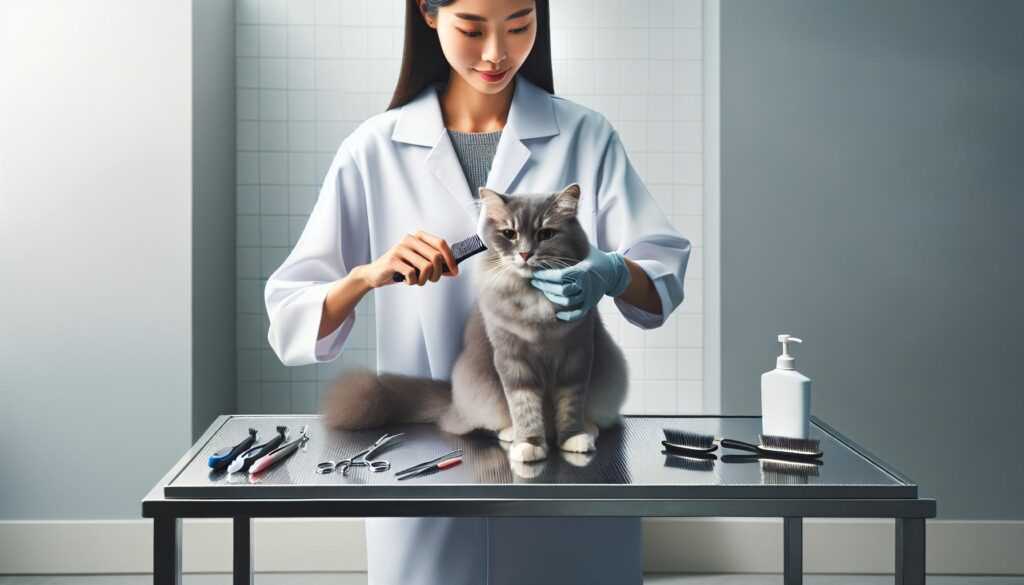What is Lymphoma in Cats?
Lymphoma ranks as one of the most prevalent types of cancer diagnosed in cats. It’s a form of cancer that affects the lymphocytes, a type of white blood cell pivotal in your cat’s immune system. Manifesting in various parts of the body, lymphoma can influence multiple organs and tissues, including the lymph nodes, liver, and spleen.
Symptoms of Lymphoma in Cats
Spotting lymphoma early can significantly impact your cat’s quality of life and treatment success. Key symptoms to watch out for include:
- Weight loss and decreased appetite: These are often the first signs cat owners notice.
- Lethargy: A marked decrease in energy or increased fatigue.
- Swollen lymph nodes: Potentially noticeable under the jaw, behind the knees, or in other parts of the body.
- Breathing difficulties or coughing: Especially if the lymphoma is affecting the chest area.
- Vomiting or diarrhoea: Symptoms that may suggest gastrointestinal lymphoma.
Being aware of these symptoms empowers you to seek veterinary advice promptly if you suspect your cat is unwell.
Causes of Lymphoma in Cats

The exact cause of lymphoma in cats remains largely unknown, however, several factors are believed to contribute to its development:
- Genetic predisposition: Some cats may be genetically more susceptible to lymphoma.
- Environmental factors: Exposure to certain chemicals or second-hand smoke might increase risk.
- Viral infections: There’s evidence to suggest that feline leukemia virus (FeLV) and feline immunodeficiency virus (FIV) infections can heighten the risk of lymphoma in cats.
Understanding these causative factors can be crucial in taking preventive steps, such as ensuring vaccinations are up to date and minimising exposure to environmental risks.
Treatment options
When you’re delving into treatment options for lymphoma in cats, it’s crucial to understand the most effective ways to combat this condition. Treatments typically focus on remission and improving the quality of life for your feline friend. Here, we’ll explore chemotherapy and radiation therapy, two primary treatments for lymphoma in cats.
Chemotherapy for Lymphoma in Cats
Chemotherapy stands out as a principal treatment for lymphoma in cats. It involves using drugs to kill cancer cells or slow their growth. Unlike in humans, chemotherapy in cats is designed to minimize discomfort, and many cats tolerate it well with few side effects.
Key Points about Chemotherapy:
- Goal: To achieve remission, where symptoms are reduced or disappear.
- Duration: Treatment length varies, typically ranging from 6 to 12 months.
- Medication: Cats may receive a combination of drugs orally or via injection.
- Side Effects: While less common than in humans, watch for lethargy, nausea, and decreased appetite.
Radiation Therapy for Lymphoma in Cats
Radiation therapy is another treatment option, particularly useful for localized lymphoma. This method uses high-energy rays to target and destroy cancer cells in specific areas.
- Precision: Targets only the affected area, minimizing damage to healthy tissues.
- Sessions: Treatment might require multiple sessions over weeks or months.
- Availability: Not as widely available as chemotherapy; might require referral to a specialist center.
Each treatment has its benefits and drawbacks, so it’s important to discuss all options with your veterinarian to decide the best course of action for your cat’s specific situation. Understanding the potential outcomes, side effects, and the commitment required for each treatment will help you make an informed decision that prioritizes your cat’s well-being.
Diagnostic methods
When you’re trying to understand the health challenges your cat may be facing, specifically regarding lymphoma, getting an accurate diagnosis is crucial. One of the key methods used for this is biopsy. Let’s delve a bit deeper into how this process helps in diagnosing lymphoma in cats.
Biopsy for Diagnosing Lymphoma in Cats
A biopsy is a diagnostic test involving the collection of a small tissue sample from your cat. This sample is then examined under a microscope by a pathologist to look for the presence of cancer cells. In the case of suspected lymphoma, a biopsy can provide definitive evidence of the disease.
There are several types of biopsies that might be conducted, depending on the location and accessibility of the lymphoma:
- Fine Needle Aspiration (FNA): This minimally invasive procedure uses a thin needle to extract cells from a lymph node or mass. It’s often the first step if lymphoma is suspected.
- Core Needle Biopsy: This involves a larger needle that removes a small cylinder of tissue. It’s more invasive than FNA but can provide a more comprehensive sample.
- Surgical Biopsy: In certain cases, a full surgical removal of a lymph node or a part of it may be necessary. This type of biopsy provides the most detailed information but is the most invasive.
The choice of biopsy method depends on several factors, including the suspected type of lymphoma, its location, and the overall health of your cat. Your vet will guide you through the best approach based on your cat’s specific situation.
Once the biopsy is performed, the waiting period for results can be anxiety-inducing. However, understanding that this process is vital for accurate diagnosis and subsequent treatment planning is important. The results from the biopsy can help your vet concoct a targeted treatment plan, including decisions on chemotherapy or radiation therapy, tailored specifically to your cat’s type of lymphoma.
Bear in mind, early detection and diagnosis are key to managing lymphoma in cats. If you notice any unusual symptoms in your cat, such as swollen lymph nodes, lethargy, or unexplained weight loss, it’s crucial to consult your vet promptly.
Personal experiences
Exploring personal experiences related to lymphoma in cats provides insights that can’t be found in medical textbooks or clinical studies alone. These stories encompass the emotional journey of pet owners, from receiving the diagnosis to navigating the day-to-day challenges, and even coping with loss. Here, we delve into the personal narratives that shed light on the different dimensions of dealing with lymphoma in cats.
Living with a Cat Diagnosed with Lymphoma
After your cat is diagnosed with lymphoma, your life and that of your pet is bound to change. Understandably, this period comes with its challenges, but also moments of joy and deep bonding. It’s important to remember that with the right treatment and care, cats diagnosed with lymphoma can still lead a comfortable, if not entirely normal, life for some time.
- Adjusting Their Environment: Start by making their living space as comfortable and stress-free as possible. Soft bedding, easy access to food, water, and litter boxes are all small adjustments that can make a big difference.
- Specialised Diet and Nutrition: Nutritional needs may change. Consulting with your vet regarding the best diet for your cat’s particular type and stage of lymphoma is crucial. High-quality protein and calorie-dense foods can often be beneficial.
- Regular Vet Visits: Regular check-ups become part of your routine. These are essential for monitoring your cat’s health and making any necessary adjustments to their treatment plan.
Caring for a cat with lymphoma is a journey that’s both emotionally and physically taxing. However, the companionship and love shared between you and your pet during this time can provide immense comfort and fulfillment to both.
Coping with the Loss of a Cat to Lymphoma
Losing a pet to lymphoma is an incredibly difficult experience. It’s a journey of grief that takes time and healing often requires a strong support system. Understanding and navigating this process is crucial for pet owners facing this reality.
- Seek Support: Reach out to friends, family, or pet loss support groups. Sharing your feelings and experiences can be a powerful way of coping.
- Memorialising Your Pet: Creating a small memorial or holding a ceremony to celebrate your cat’s life can be a meaningful way to say goodbye and remember the joy they brought into your life.
- Self-Care: Remember to take care of yourself during this emotional time. Allow yourself to feel and express your grief. Everyone’s journey to healing is unique and it’s important to move at your own pace.
The loss of a cat to lymphoma is a profound experience that leaves a lasting impact. For many, it’s a period of reflection on the love and companionship shared with their pet. Over time, while the pain might lessen, the memories and bonds forged with your cat endure.
Frequently Asked Questions
What is the key method for diagnosing lymphoma in cats?
The key method used for diagnosing lymphoma in cats is a biopsy. Depending on the suspected location of the lymphoma, various types of biopsies can be performed to confirm the diagnosis.
Why is early detection of lymphoma in cats important?
Early detection of lymphoma in cats is crucial as it can significantly affect the effectiveness of the treatment. Early diagnosis allows for the prompt commencement of treatment, potentially improving the cat’s quality of life and longevity.
What should you do if you notice unusual symptoms in your cat?
If you notice unusual symptoms in your cat, it is important to consult with a veterinarian promptly. They can assess your cat’s symptoms and, if necessary, carry out tests to diagnose the underlying cause.
How can pet owners care for a cat diagnosed with lymphoma?
Caring for a cat diagnosed with lymphoma may involve adjusting the cat’s environment for comfort, providing a specialized diet, ensuring regular veterinary visits, and possibly administering prescribed treatments. Emotional support and palliative care are also critical aspects of care.
How can pet owners cope with the loss of a cat to lymphoma?
Coping with the loss of a cat to lymphoma involves seeking support from friends, family, or support groups, memorializing the pet in a meaningful way, and practicing self-care to navigate the grieving process. It’s vital to acknowledge the loss and give oneself permission to grieve.



